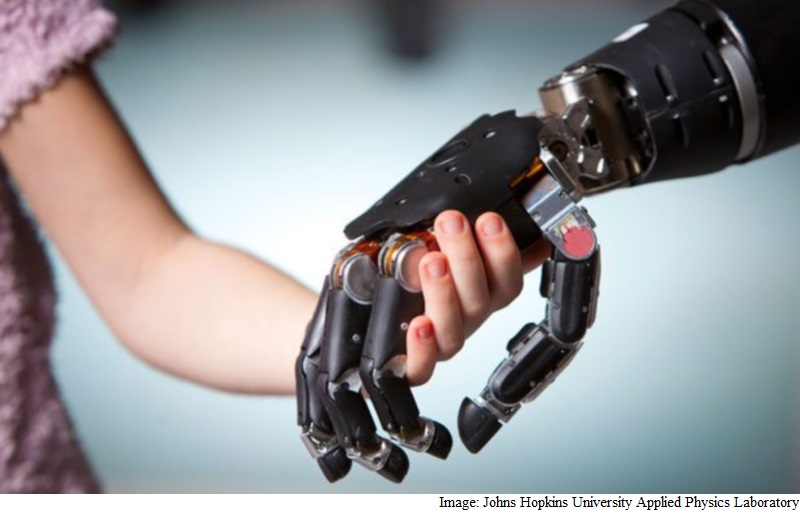- Home
- Science
- Science News
- Prosthetics That Recreate Sense of Touch in the Offing: Study
Prosthetics That Recreate Sense of Touch in the Offing: Study

A new study shows that artificial touch is highly dependent on several features of electrical stimuli, such as the strength and frequency of signals.
It describes the specific characteristics of these signals, including how much each feature needs to be adjusted to produce a different sensation.
"This is where the rubber meets the road in building touch-sensitive neuroprosthetics," said Sliman Bensmaia, associate professor at the University of Chicago and senior author of the study.
"Now we understand the nuts and bolts of stimulation, and what tools are at our disposal to create artificial sensations by stimulating the brain," said Bensmaia.
Bensmaia's research is part of Revolutionising Prosthetics, a multi-year Defence Advanced Research Projects Agency project that seeks to create a modular, artificial upper limb that will restore natural motor control and sensation in amputees.
Bensmaia and his UChicago colleagues are working specifically on the sensory aspects of these limbs. For this study, monkeys, whose sensory systems closely resemble those of humans, had electrodes implanted into the area of the brain that processes touch information from the hand. The animals were trained to perform two perceptual tasks: one in which they detected the presence of an electrical stimulus, and a second in which they indicated which of two successive stimuli was more intense.
During these experiments, Bensmaia and his team manipulated various features of the electrical pulse train, such as its amplitude, frequency and duration, and noted how the interaction of each of these factors affected the animals' ability to detect the signal.
Of specific interest were the "just-noticeable differences," (JND) or the incremental changes needed to produce a sensation that felt different.
For instance, at a certain frequency, the signal may be detectable first at a strength of 20 microamperes of electricity. If the signal has to be increased to 50 microamperes to notice a difference, the JND in that case is 30 microamperes.
The sense of touch is really made up of a complex and nuanced set of sensations, from contact and pressure to texture, vibration and movement. By documenting the range, composition and specific increments of signals that create sensations that feel different from each other, Bensmaia and his colleagues have provided the "notes" scientists can play to produce the "music" of the sense of touch in the brain.
"When you grasp an object, for example, you can hold it with different grades of pressure. To recreate a realistic sense of touch, you need to know how many grades of pressure you can convey through electrical stimulation," Bensmaia said.
The study was published in the journal PNAS.
Get your daily dose of tech news, reviews, and insights, in under 80 characters on Gadgets 360 Turbo. Connect with fellow tech lovers on our Forum. Follow us on X, Facebook, WhatsApp, Threads and Google News for instant updates. Catch all the action on our YouTube channel.
Related Stories
- Samsung Galaxy Unpacked 2025
- ChatGPT
- Redmi Note 14 Pro+
- iPhone 16
- Apple Vision Pro
- Oneplus 12
- OnePlus Nord CE 3 Lite 5G
- iPhone 13
- Xiaomi 14 Pro
- Oppo Find N3
- Tecno Spark Go (2023)
- Realme V30
- Best Phones Under 25000
- Samsung Galaxy S24 Series
- Cryptocurrency
- iQoo 12
- Samsung Galaxy S24 Ultra
- Giottus
- Samsung Galaxy Z Flip 5
- Apple 'Scary Fast'
- Housefull 5
- GoPro Hero 12 Black Review
- Invincible Season 2
- JioGlass
- HD Ready TV
- Laptop Under 50000
- Smartwatch Under 10000
- Latest Mobile Phones
- Compare Phones
- Realme P4x 5G
- OnePlus Ace 6T
- Nubia Flip 3
- Nubia Fold
- OPPO A6x 5G
- Samsung Galaxy Z TriFold
- Poco F8 Ultra
- Poco F8 Pro
- Asus ProArt P16
- MacBook Pro 14-inch (M5, 2025)
- Poco Pad M1
- Poco Pad X1
- Just Corseca Skywatch Pro
- Honor Watch X5
- Acerpure Nitro Z Series 100-inch QLED TV
- Samsung 43 Inch LED Ultra HD (4K) Smart TV (UA43UE81AFULXL)
- Asus ROG Ally
- Nintendo Switch Lite
- Haier 1.6 Ton 5 Star Inverter Split AC (HSU19G-MZAID5BN-INV)
- Haier 1.6 Ton 5 Star Inverter Split AC (HSU19G-MZAIM5BN-INV)

















